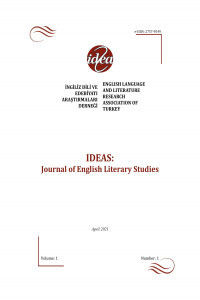Samuel Beckett's Breath on Screen: Damien Hirst’s Adaptation
Samuel Beckett's Breath on Screen: Damien Hirst’s Adaptation
Samuel Beckett, Breath, Damien Hirst, Adaptation Object voice,
___
- Avari, Burjor. India: The Ancient Past: A History of the Indian Subcontinent from c. 7000 BCE to CE 1200. Routledge, 2016.
- Bair, Deirdre. Samuel Beckett: A Biography. Simon & Schuster, 1990.
- Beckett, Samuel. The Collected Shorter Plays. Grove, 1984.
- Brater, Enoch. Why Beckett. Thames & Hudson, 1989.
- Breath. Directed by Damien Hirst, Blue Angel, 2000.
- Campbell, Julie. “‘Echo’s Bones’ and Beckett’s Disembodied Voices.” Samuel Beckett: Endlessness in the Year 2000, edited by Angela B. Moorjani and Carola Veit, Rodopi, 2001, pp. 454-468.
- Caponigro, Andy. The Miracle of the Breath: Mastering Fear, Hearing Illness, and Experiencing the Divine. New World Library, 2010.
- Chion, Michel. Film, A Sound Art. Translated by Claudia Gorbman, Columbia UP, 2009.
- Dolar, Mladen. A Voice and Mothing More. Edited by Slavoj Žižek, MIT, 2006.
- Elst, Koenraad. “Return of the Swastika.” Return of the Swastika: Hate and Hysteria versus Hindu Sanity. Arktos, 2015, pp. 243-247.
- Gilbert, Elizabeth. “Your Elusive Creative Genius.” TED: Ideas Worth Spreading, February 2019, https://www.ted.com/talks/elizabeth_gilbert_your_elusive_creative_genius.
- Gontarski, S. E. “Reinventing Beckett.” Modern Drama, vol. 49, no. 4, 2006, pp. 428-451. doi: 10.3138/md.49.4.428.
- Goudouna, Sozita. “Shortness of Breath: Beckett’s Breath in Context.” Beckett’s Breath: Anti-Theatricality and the Visual Arts. Edinburgh UP, 2018, pp. 105-119.
- Gussow, Mel. Conversations with and about Beckett. Grove, 1996.
- Hischak, Thomas S. Theatre as Human Action: An Introduction to Theatre Arts. Rowman & Littlefield, 2019.
- Hutcheon, Linda. A Theory of Adaptation. Routledge, 2013.
- Hutchings, William. “Saving Your Breath – And Beckett’s Too.” Text & Presentation, 2006, edited by Stratos E. Constantinidis. McFarland, 2006, pp. 16-22.
- Law, Jonathan. The Methuen Drama Dictionary of the Theatre. Bloomsbury, 2011.
- Liungman, Carl G. Symbols: Encyclopedia of Western Signs and Ideograms. HME, 1995.
- Pope, Rob. Creativity: Theory, History, Practice. Routledge, 2005.
- The Book of Joshua. By Marten H. Woudstra. W. B. Eerdmans, 1981.
- The Complete Evangelical Parallel Bible. Hendrickson, 2012.
- The Holy Qur’an: Text, Translation and Commentary. Translated by Abdullah Yusuf Ali, The Islamic Foundation, 1975.
- Žižek, Slavoj. “‘I Hear You with My Eyes’; or, The Invisible Master.” Gaze and Voice as Love Objects, edited by Renata Salecl and Slavoj Žižek, Duke UP, 1996, pp. 90-126.
- Başlangıç: 2021
- Yayıncı: İngiliz Dili ve Edebiyatı Araştırmaları Derneği / English Language and Literature Research Association of Turkey
Review of The Force of Non-Violence: An Ethico-Political Bind
Marietta KOSMA, Amir PİCHHADZE
Gender and Domestic Space in Ahmed Ali's and Krishna Sobti's Novels on Old Delhi
Jacobean Morality and Moral Performativity in Volpone and Women Beware Women
A. J. Greimas in Jakarta: Essay on Story Structure
Samuel Beckett's Breath on Screen: Damien Hirst’s Adaptation
Dialectics of Place and Space in Forster's A Passage to India: A Lacanian Reading
